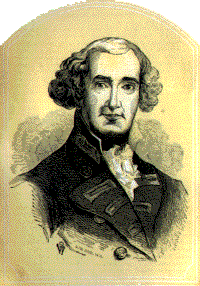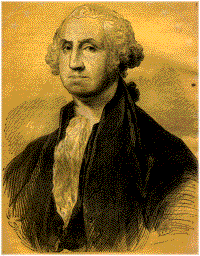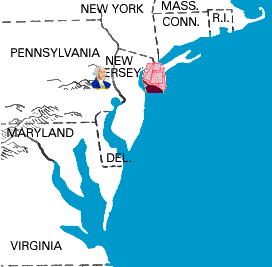|

all information provided from ushistory.org
|
Background to the
Campaign
|
The British
defeated the French and their Indian allies in the French and Indian War (1754-1763). The result was British
control over much of North America. But the war had cost England a great deal
of money and Parliament decided it was time for the Colonies to pay a share
for their own defense.

|
To raise money, Parliament
passed the Stamp Act in 1765. This law required the purchase of tax
stamps to buy paper.
The Colonists were outraged. After years of "Salutary Neglect"
wherein Colonial taxes were not collected by the British, the new policy was
unwelcome.
The Colonists had always considered themselves Englishmen. Among the rights
granted to all Englishmen was a voice in Parliament -- something they didn't
have. With the Stamp Act, "Taxation without representation is
tyranny," became a battle cry. Rioting, rhetoric, and the calling of the
Stamp Act Congress quickly led England to repeal the Stamp Act.
But many new taxation measures, such as the Sugar Act and Townshend Acts
followed. The Americans reacted by forming organized political groups such as
Committees of Correspondence and the Sons of Liberty.

|
The people of Boston were
most outspoken and violent in their reaction to taxes. They threatened and
harmed British customs officials trying to collect taxes. So, the British
quartered troops in Boston to protect their officials. In 1770, the
Boston Massacre occurred as British troops fired into a group of protesters,
killing five of them. This was the first blood.
In 1773 the East India Company was granted a virtual monopoly on the
importation of tea. In protest, a group of Boston citizens disguised as Mohawk
Indians boarded a ship and dumped 342 chests of tea into Boston harbor.
Parliament responded with the "Intolerable Acts."
- Accused Colonists
could be tried in England
- American homes were
forced to host British troops
- Boston Harbor was
closed
- And more

|
This resulted in the First
Continental Congress, in 1774, which met at Philadelphia's Carpenters'
Hall. Twelve colonies sent delegates to discuss how to return to a state of
harmonious relations with the Mother Country -- not revolution! But radical
thinking won out. Parliamentary acts were declared
"unconstitutional." Taxes were not paid, an import-export ban was
established, and Colonists were urged to arm themselves.
The "shot heard 'round the world" was fired at Lexington where armed
colonists tried to resist British seizure of an arsenal. Eight Americans and
273 British soldiers were killed. The Revolution began.
The Second Continental Congress met in Philadelphia on May 10, 1775 and
they declared themselves the government. They also named George Washington
Commander in Chief of the newly organized army.
In June 1775, the Battle of Bunker Hill resulted in about 400 American
and 1,054 British fatalities. The first major battle of the War gave the
Americans great confidence.
Skirmishes in late 1775 led to the capture of Ft. Ticonderoga in New
York and a win at the Battle of Crown Point, under the command of Ethan Allen.
However, Benedict Arnold's attempt to capture Canada for the Americans failed.
 On July 4th, 1776,
Congress adopts the Declaration of Independence. The United States is born. On July 4th, 1776,
Congress adopts the Declaration of Independence. The United States is born.
30,000 British troops arrived in New York Harbor in August and joined
those already under the command of General William Howe. American defeats
followed at Long Island, Harlem Heights, and White Plains.
The Americans salvaged a dismal year with Washington's Christmas night
crossing of the Delaware to capture Trenton. This was followed up shortly
after by a victory at the Battle of Princeton. The Americans chased Howe back
to New York. Washington went into winter quarters in Morristown, New Jersey.
In the Spring of 1777, The Philadelphia Campaign was about to unfold.
Background
to the Campaign:
The British |

Military Journal of the American Revolution
General William Howe
|
Part of the overall British design
to win the war was to isolate regions of the country and invoke the support of
silent Loyalists.
General Howe, Commander of British troops in the Colonies, had a two-pronged
plan for 1777. While the British army of the North under General Burgoyne
would march down from Canada to capture Albany, isolating New England, the
Southern army under Howe would capture Philadelphia.
With the capital under occupation, and radical New England isolated, Howe
hoped to force a surrender.
Winter, according to the military custom of the 18th century, was not a season
to pursue battle. After a string of successful battles in 1776, General Howe
spent the winter in New York City.
Dallying overlong there, it was not until June 1777 that Howe made a
non-productive feint into New Jersey. But due to a fear of losing his supply
line, the vacillating general performed an about-face and returned to New
York.

Library of Congress
King George III of England
|
Back in London, Parliament, fed up
with this Colonial rebellion and tired of bearing the burden of a costly war,
wanted results. Howe, recently named Knight Companion of the Bath by King
George III, needed to score a victory quickly -- the new "Sir
William" had a title to live up to.
Yet, the fighting season was nearing an end without a single major engagement
having taken place. Howe was finally ready to engage the enemy, capture
Philadelphia, and show the King and Parliament that he was bringing the war to
a close.
Background
to the Campaign:
The Americans |

Military Journal of the American Revolution
General George Washington
|
George Washington had spent the
winter of 1776 in Morristown, New Jersey, keeping an eye on Howe in New York.
In Upstate New York, General Gates and the Northern Army prepared for an
invasion by General Burgoyne, who was coming from Canada.
Washington didn't know if Howe was planning to move north into New York State
to support Burgoyne or south to invade Philadelphia.
In June 1777, Washington learned about a massive flotilla that was boarding in
Sandy Hook, New Jersey, across from Staten Island, destination unknown.
By late in July, Washington knew it was heading down the Atlantic coast.
Washington moved his army of approximately 11,000 troops by land to
Wilmington, Delaware, about 20 miles north of where Howe would ultimately land
and 20 miles south of Philadelphia.
General Washington, well placed for Howe's arrival, but wary nonetheless,
needed an estimation of Howe's troop strength for this campaign and what to
expect in planning this new phase of engagement.
Washington's previous appearances on the battlefield resulted in
morale-boosting victories at Princeton and Trenton, but that was eight months
past.
Whispers within Congress and even among some serving with him questioned the
Commander's capabilities.
Both armies were in place prepared to
play out the Philadelphia Campaign of 1777.

||| 5 PAGES TO FOLLOW ||| |
In late July 1777, a 265-ship armada
under General Howe's command finally arrived at the Head of Maryland's Elk
River. 17,000 soldiers aboard the ships had endured a debilitating six week
journey originating at Sandy Hook, New Jersey, across from Staten Island,
New York.
Howe
had hoped to complete the trip much faster than he did. He didn't. In
Maryland, he hoped to find a legion of Loyalists ready to fight with the
British. He didn't.
What he did have to do was to get all his ships unloaded of men, horses,
weapons and supplies. Then he had to begin his march on Philadelphia to the
north.
In between, stood George Washington and the Continental Army ready to stop
him.]
Howe's Voyage
The largest armada ever assembled in
America set sail off of Sandy Hook, New Jersey. It was carrying 17,000
British soldiers and sailors in over 260 ships. The armada was headed for
an attack on the capital city of Philadelphia. They underwent a
distressful 34-day sea-trek. The voyage took its toll in lost time,
seasick soldiers, and scores of dead horses.

©1997 Independence Hall Association |
Washington's troops started in northern
New Jersey and shadowed the movement of the British fleet.
Washington lost sight of the fleet for an agonizing three-week period,
starting when the armada moved further offshore as it passed the Delaware
Capes. He feared that the fleet may have doubled back to New York to help
General Burgoyne in his attempt to capture upstate New York against the
Americans headed by General Gates.
Until he could determine the destination of the fleet, Washington needed
to maintain a position where he could move north or south. When their
destination was clear, Washington moved south to a position between Head
of Elk and Philadelphia.


|










